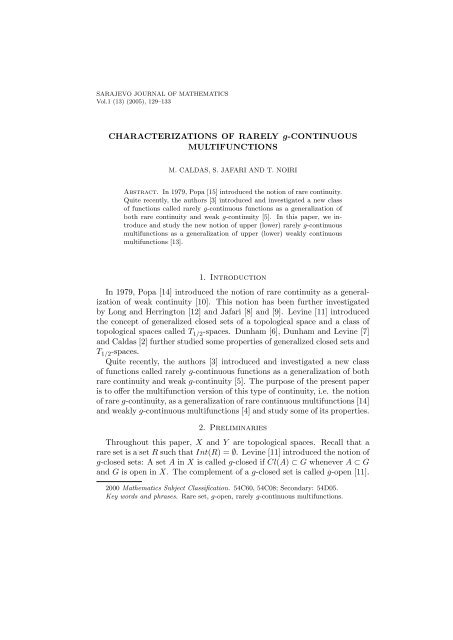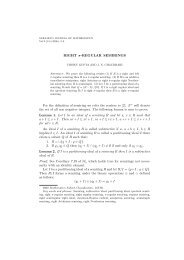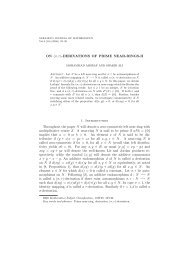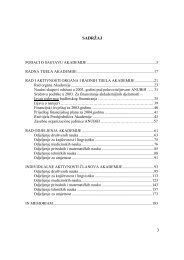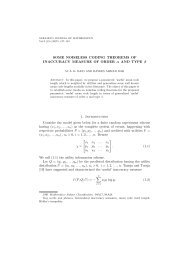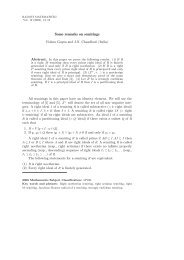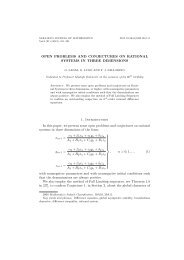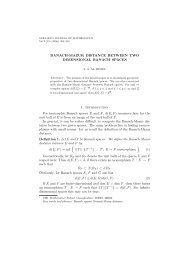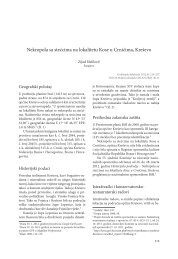M. Caldas, S. Jafari and T. Noiri
M. Caldas, S. Jafari and T. Noiri
M. Caldas, S. Jafari and T. Noiri
You also want an ePaper? Increase the reach of your titles
YUMPU automatically turns print PDFs into web optimized ePapers that Google loves.
SARAJEVO JOURNAL OF MATHEMATICS<br />
Vol.1 (13) (2005), 129–133<br />
CHARACTERIZATIONS OF RARELY g-CONTINUOUS<br />
MULTIFUNCTIONS<br />
M. CALDAS, S. JAFARI AND T. NOIRI<br />
Abstract. In 1979, Popa [15] introduced the notion of rare continuity.<br />
Quite recently, the authors [3] introduced <strong>and</strong> investigated a new class<br />
of functions called rarely g-continuous functions as a generalization of<br />
both rare continuity <strong>and</strong> weak g-continuity [5]. In this paper, we introduce<br />
<strong>and</strong> study the new notion of upper (lower) rarely g-continuous<br />
multifunctions as a generalization of upper (lower) weakly continuous<br />
multifunctions [13].<br />
1. Introduction<br />
In 1979, Popa [14] introduced the notion of rare continuity as a generalization<br />
of weak continuity [10]. This notion has been further investigated<br />
by Long <strong>and</strong> Herrington [12] <strong>and</strong> <strong>Jafari</strong> [8] <strong>and</strong> [9]. Levine [11] introduced<br />
the concept of generalized closed sets of a topological space <strong>and</strong> a class of<br />
topological spaces called T 1/2-spaces. Dunham [6], Dunham <strong>and</strong> Levine [7]<br />
<strong>and</strong> <strong>Caldas</strong> [2] further studied some properties of generalized closed sets <strong>and</strong><br />
T 1/2-spaces.<br />
Quite recently, the authors [3] introduced <strong>and</strong> investigated a new class<br />
of functions called rarely g-continuous functions as a generalization of both<br />
rare continuity <strong>and</strong> weak g-continuity [5]. The purpose of the present paper<br />
is to offer the multifunction version of this type of continuity, i.e. the notion<br />
of rare g-continuity, as a generalization of rare continuous multifunctions [14]<br />
<strong>and</strong> weakly g-continuous multifunctions [4] <strong>and</strong> study some of its properties.<br />
2. Preliminaries<br />
Throughout this paper, X <strong>and</strong> Y are topological spaces. Recall that a<br />
rare set is a set R such that Int(R) = ∅. Levine [11] introduced the notion of<br />
g-closed sets: A set A in X is called g-closed if Cl(A) ⊂ G whenever A ⊂ G<br />
<strong>and</strong> G is open in X. The complement of a g-closed set is called g-open [11].<br />
2000 Mathematics Subject Classification. 54C60, 54C08; Secondary: 54D05.<br />
Key words <strong>and</strong> phrases. Rare set, g-open, rarely g-continuous multifunctions.
130 M. CALDAS, S. JAFARI AND T. NOIRI<br />
The family of all g-open (resp. open) sets will be denoted by GO(X) (resp.<br />
O(X)). We set GO(X, x) = {U | x ∈ U ∈ GO(X)}, O(X, x) = {U | x ∈<br />
U ∈ O(X)} <strong>and</strong> O(X, A) = {U | A ⊂ U ∈ O(X)}. The g-interior of A,<br />
denoted by Intg(A), is defined by Intg(A) = {U ∈ GO(X) | U ⊂ A}.<br />
Note that for any subsets A <strong>and</strong> B of a space X, Intg(A) ⊂ Intg(B) if<br />
A ⊂ B.<br />
Definition 1. A function f : X → Y is called:<br />
i) weakly continuous [10] (resp. weakly-g-continuous [4]) if for each<br />
x ∈ X <strong>and</strong> each open set G containing f(x), there exists U ∈ O(X, x)<br />
(resp. U ∈ GO(X, x)) such that f(U) ⊂ Cl(G),<br />
ii) rarely continuous [14] (resp. rarely g-continuous [3])if for each x ∈ X<br />
<strong>and</strong> each G ∈ O(Y, f(x)), there exist a rare set RG with G∩Cl(RG) =<br />
∅ <strong>and</strong> U ∈ O(X, x) (resp. U ∈ GO(X, x)) such that f(U) ⊂ G ∪ RG,<br />
iii) g-continuous [1] if the inverse image of every closed set in Y is gclosed<br />
in X.<br />
Note that, every weakly continuous function is rarely continuous <strong>and</strong> every<br />
rarely continuous function is rarely g-continuous.<br />
3. Upper (lower) rarely g-continuous multifunctions<br />
We provide the following definitions which will be used in the sequel. Let<br />
F : X → Y be a multifunction. The upper <strong>and</strong> lower inverses of a set V ⊂ Y<br />
are denoted by F + (V ) <strong>and</strong> F − (V ) respectively, that is,<br />
<strong>and</strong><br />
F + (V ) = {x ∈ X|F (x) ⊂ V }<br />
F − (V ) = {x ∈ X|F (x) ∩ V = ∅}.<br />
Definition 2. A multifunction F : X → Y is said to be<br />
(i) upper rarely g-continuous ( briefly u.r.g.c)at x ∈ X if for each V ∈<br />
O(Y, F (x)), there exist a rare set RV with V ∩ Cl(RV ) = ∅ <strong>and</strong><br />
U ∈ GO(X, x) such that F (U) ⊂ V ∪ RV ,<br />
(ii) lower rarely g-continuous ( briefly l.r.g.c) at x ∈ X if for each V ∈<br />
O(Y ) with F (x)∩V = ∅ there exist a rare set RV with V ∩Cl(RV ) =<br />
∅ <strong>and</strong> U ∈ GO(X, x) such that F (u) ∩ (V ∪ RV ) = ∅ for every u ∈ U,<br />
(iii) upper/lower rarely g-continuous if it is upper/lower rarely g-continuous<br />
at each point of X.<br />
Definition 3. ([4]) A multifunction F : X → Y is said to be<br />
(i) upper weakly g-continuous at x ∈ X if for each V ∈ O(Y, F (x)),<br />
there exist U ∈ GO(X, x) such that F (U) ⊂ Cl(V ),
g-CONTINUOUS MULTIFUNCTIONS 131<br />
(ii) lower weakly g-continuous at x ∈ X if for each V ∈ O(Y ) with<br />
F (x)∩V = ∅, there exists U ∈ GO(X, x) such that F (u)∩Cl(V ) = ∅<br />
for every u ∈ U,<br />
(iii) upper/lower weakly g-continuous if it is upper/lower weakly g-continuous<br />
at each point of X.<br />
Theorem 1. The following statements are equivalent for a multifunction<br />
F : X → Y :<br />
(i) F is u.r.g.c at x ∈ X,<br />
(ii) For each V ∈ O(Y, F (x)), there exists U ∈ GO(X, x) such that<br />
Int[F (U) ∩ (Y − V )] = ∅,<br />
(iii) For each V ∈ O(Y, F (x)), there exists U ∈ GO(X, x) such that<br />
Int[F (U)] ⊂ Cl(V ).<br />
Proof. (i) ⇒ (ii): Let V ∈ O(Y, F (x)). By F (x) ⊂ V ⊂ Int(Cl(V )) <strong>and</strong> the<br />
fact that Int(Cl(V )) ∈ O(Y ), there exist a rare set RV with Int(Cl(V )) ∩<br />
Cl(RV ) = ∅ <strong>and</strong> a g-open set U ⊂ X containing x such that F (U) ⊂<br />
Int(Cl(V ))∪RV . We have Int[F (U)∩(Y −V )] = Int(F (U))∩Int(Y −V ) ⊂<br />
Int(Cl(V ) ∪ RV ) ∩ (Y − Cl(V )) ⊂ (Cl(V ) ∪ Int(RV )) ∩ (Y − Cl(V )) = ∅.<br />
(ii) ⇒ (iii) : Obvious.<br />
(iii) ⇒ (i) : Let V ∈ O(Y, F (x)). Then, by (iii) there exists U ∈<br />
GO(X, x) such that Int[F (U)] ⊂ Cl(V ). Thus F (U) = [F (U)−Int(F (U))]∪<br />
Int[F (U)] ⊂ [F (U) − Int(F (U))] ∪ Cl(V ) = [F (U) − Int(F (U))] ∪ V ∪<br />
(Cl(V ) − V ) = [(F (U) − Int(F (U)) ∩ (Y − V )] ∪ V ∪ (Cl(V ) − V ). Put<br />
P = (F (U) − Int(F (U))) ∩ (Y − V ) <strong>and</strong> G = Cl(V ) − V , then P <strong>and</strong> G are<br />
rare sets. Moreover, RV = P ∪ G is a rare set such that Cl(RV ) ∩ V = ∅<br />
<strong>and</strong> F (U) ⊂ V ∪ RV . Hence F is u.r.g.c. <br />
Theorem 2. The following are equivalent for a multifunction F : X → Y :<br />
(i) F is l.r.g.c at x ∈ X,<br />
(ii) For each V ∈ O(Y ) such that F (x) ∩ V = ∅ there exists a rare set<br />
RV with V ∩ Cl(RV ) = ∅ such that x ∈ Intg(F − (V ∪ RV )),<br />
(iii) For each V ∈ O(Y ) such that F (x) ∩ V = ∅, there exists a rare set<br />
RV with Cl(V ) ∩ RV = ∅ such that x ∈<br />
Intg(F − (Cl(V ) ∪ RV )),<br />
(iv) For each V ∈ RO(Y ) such that F (x) ∩ V = ∅, there exists a rare set<br />
RV with V ∩ Cl(RV ) = ∅ such that x ∈ Intg(F − (V ∪ RV )).<br />
Proof. (i) ⇒ (ii) : Let V ∈ O(Y ) such that F (x) ∩ V = ∅. By (i), there<br />
exist a rare set RV with V ∩ Cl(RV ) = ∅ <strong>and</strong> U ∈ GO(X, x) such that<br />
F (x) ∩ (V ∪ RV ) = ∅ for each u ∈ U. Therefore, u ∈ F − (V ∪ RV ) for<br />
each u ∈ U <strong>and</strong> hence U ⊂ F − (V ∪ RV ). Since U ∈ GO(X, x), we obtain<br />
x ∈ U ⊂ Intg(F − (V ∪ RV )).
132 M. CALDAS, S. JAFARI AND T. NOIRI<br />
(ii) ⇒ (iii) : Let V ∈ O(Y ) such that F (x) ∩ V = ∅. By (ii), there<br />
exists a rare set RV with V ∩ Cl(RV ) = ∅ such that x ∈ Intg(F − (V ∪ RV )).<br />
We have RV ⊂ Y − V = (Y − Cl(V )) ∪ (Cl(V ) − V ) <strong>and</strong> hence RV ⊂<br />
[RV ∩(Y −Cl(V ))]∪(Cl(V )−V ). Now, put P = RV ∩(Y −Cl(V )). Then P<br />
is a rare set <strong>and</strong> P ∩Cl(V ) = ∅. Moreover, we have x ∈ Intg(F − (V ∪RV )) ⊂<br />
Intg(F − (P ∪ Cl(V ))).<br />
(iii) ⇒ (iv) : Let V be any regular open set of Y such that F (x) ∩ V =<br />
∅. By (iii), there exists a rare set RV with Cl(V ) ∩ RV = ∅ such that<br />
x ∈ Intg(F − (Cl(V ) ∪ RV )). Put P = RV ∪ (Cl(V ) − V ), then P is a rare<br />
set <strong>and</strong> V ∩ Cl(P ) = ∅. Moreover, we have x ∈ Intg(F − (Cl(V ) ∪ RV )) =<br />
Intg(F − (R ∪ (Cl(V ) − V ) ∪ V )) = Intg(F − (P ∪ V )).<br />
(iv) ⇒ (i) : Let V ∈ O(Y ) such that F (x) ∩ V = ∅. Then F (x) ∩<br />
Int(Cl(V )) = ∅ <strong>and</strong> Int(Cl(V )) is regular open in Y . By (iv), there exists<br />
a rare set RV with V ∩ Cl(RV ) = ∅ such that x ∈ Intg(F − (V ∪ RV )).<br />
Therefore, there exists U ∈ GO(X, x) such that U ⊂ F − (V ∪ RV ); hence<br />
F (u) ∩ (V ∪ RV ) = ∅ for each u ∈ U. This shows that F is lower rarely<br />
g-continuous at x. <br />
Corollary 1. ([[3], Theorem 2]) The following statements are equivalent for<br />
a function f : X → Y :<br />
(i) f is rarely g-continuous at x ∈ X,<br />
(ii) For V ∈ O(Y, f(x)), there exists U ∈ GO(X, x) such that Int[f(U) ∩<br />
(Y − V )] = ∅,<br />
(iii) For each V ∈ O(Y, f(x)), there exists U ∈ GO(X, x) such that<br />
Int[f(U)] ⊂ Cl(V ).<br />
Acknowledgement. The authors are very grateful to the referee for his<br />
comments which improved this paper.<br />
References<br />
[1] K. Balach<strong>and</strong>ran, P. Sundaran <strong>and</strong> H. Mak, On generalized continuous maps in topological<br />
spaces, Mem. Fac. Sci. Kochi Univ. (Ser. A Math.), 12 (1991), 5–13.<br />
[2] M. <strong>Caldas</strong>, On g–closed sets <strong>and</strong> g–continuous mappings, Kyungpook Math. J., 33<br />
(1993), 205–209.<br />
[3] M. <strong>Caldas</strong> <strong>and</strong> S. <strong>Jafari</strong>, On rarely g–continuous functions, Glas. Mat. Ser. III (to<br />
appear).<br />
[4] M. <strong>Caldas</strong>, S. <strong>Jafari</strong> <strong>and</strong> T. <strong>Noiri</strong>, Characterizations of weakly g–continuous multifunctions<br />
(under preparation).<br />
[5] M. <strong>Caldas</strong>, S. <strong>Jafari</strong> <strong>and</strong> T. <strong>Noiri</strong>, Properties of weakly g–continuous functions (under<br />
preparation.<br />
[6] Dunham, T1/2–spaces, Kyungpook Math. J., 17 (1977), 161–169.
g-CONTINUOUS MULTIFUNCTIONS 133<br />
[7] Dunham <strong>and</strong> N. Levine, Further results on generalized closed sets in topology, Kyungpook<br />
Math. J., 20 (1980), 164–175.<br />
[8] S. <strong>Jafari</strong>, A note on rarely continuous functions, Stud. Cercet. Stiint., Ser. Mat.,<br />
Univ. Bacau, 5 (1995), 29–34.<br />
[9] S. <strong>Jafari</strong>, On some properties of rarely continuous functions, Stud. Cercet. Stiint.,<br />
Ser. Mat., Univ. Bacau, 7 (1997), 65–73.<br />
[10] N. Levine, A decomposition of continuity in topological spaces, Amer. Math. Monthly,<br />
(60) (1961), 44–46.<br />
[11] N. Levine, Generalized closed sets in topological, Rend. Circ. Mat. Palermo, 19<br />
(2)(1970), 89–96.<br />
[12] P. E. Long <strong>and</strong> L. L. Herrington, Properties of rarely continuous functions, Glas. Mat.<br />
Ser. III 17 (37) (1982), 147–153.<br />
[13] V. Popa, Weakly continuous multifunctions, Boll. Unione Mat. Ital., (5), 15(A) (1978),<br />
379–388.<br />
[14] V. Popa, Some properties of rarely continuous multifunctions, Conf. Nat. Geom.<br />
Topologie, Univ. Al. I. Cuza Iasi, (1989), 269–274.<br />
[15] V. Popa, Sur certain decomposition de la continuité dans les espaces topologiques,<br />
Glas. Mat. Ser. III, 14 (34)(1979), 359–362.<br />
(Received: November 11, 2004) M. <strong>Caldas</strong><br />
(Revised: January 24, 2005) Departamento de Matematica Aplicada<br />
Universidade Federal Fluminense<br />
Rua Mario Santos Braga, s/n<br />
24020-140, Niteroi, RJ Brasil<br />
E-mail: gmamccs@vm.uff.br<br />
S. <strong>Jafari</strong><br />
Department of Mathematics <strong>and</strong> Physics<br />
Roskilde University, Postbox 260<br />
4000 Roskilde, Denmark<br />
E-mail: sjafari@ruc.dk<br />
T. <strong>Noiri</strong><br />
2949-1 Shiokita-cho, Hinagu<br />
Yatsushiro-shi, Kumamoto-ken<br />
869-5142 Japan<br />
E-mail: noiri@as.yatsushiro-nct.ac.jp


